Dipankar Goswamy, RaagRang Project: ‘What does music look like?’
Dipankar Goswamy, visual effects lead on Spiderman – Into the Spider-Verse that won the Academy Award for best animated feature film in 2019, has been associated with a number of projects including The Sea Beast, Vivo, Kingsman – The Golden Circle, Smurfs: The Lost Village, The Amazing Spiderman 2, and Oz the Great and Powerful. An alumnus of IDC, IIT, Mumbai, Goswamy, who has won numerous industry accolades, now creates photorealistic as well as painterly imagery for feature films with Sony Pictures Imageworks. Few, however, knew about his passion for providing a visual component to Indian classical music until the Bangalore International Centre (BIC) and the Museum of Art and Photography (MAP) live streamed his RaagRang: A Visual Exploration of North Indian Classical Music on 29 July 2022.
A powerful audio-visual experience, the stream presented paintings interwoven with the ragas they depicted. The voice-over included descriptions of the concept and logic behind each work. Goswamy has been working on the “portrayal” of raag-sangeet for over a decade and the project explores the intangible, abstract quality of Hindustani classical music through the tangible arts of painting, calligraphy, and through architectural three-dimensional effects and colour. “In a great concert, as the raga unfolds, the binaries disappear – the musician becomes the raga and the raga, the artiste. Ultimately, only the music remains,” says Goswamy, who attempts to express this process through the depiction of ragas rendered by those artists whose music has deeply moved him.
“For the last 13 years, I have been working on this personal project, a labour of love. It is an attempt to find an answer to the simple but inherently complex question ‘What does music look like?’ in the context of Indian classical music. This exploration has led me to create around 20 traditional paintings based on 14 themes of North Indian classical music. It is an ongoing project since the subject is so vast,” he says revealing that the aim is to present the often-intangible musical process by highlighting its multiple facets through traditional art and through innovations in computer graphics.
Planned in progressive stages, the RaagRang project begins with a series of paintings of famous musicians. Subsequent stages employ a more abstract visual language, creating an impressionistic colour imagery of these musical renditions, followed by a possible depiction of music as sculpture or three-dimensional paintings.
Loaded with visual metaphors, the paintings dig deep into the raag as well as the individuality of each musician. Dipankar liberally uses calligraphy in Devanagari and Nastaliq scripts to accentuate the swaras (notes) of the raag being rendered. Sometimes the Devanagiri is rendered like the Thuluth or the Siddham scripts to further enhance the message.
Each painting has something specific to say about the raag and the musician associated with it.
Raag Asawari sung by Gangu Bai Hangal, for instance, has the colours of the morning raag illuminating her face as calligraphy cascades down the sides of the image of the singer immersed in the dhyaan of the raag.
The ghazal Mere humnafas, mere humnawaan, mujhe dost ban ke dagha na de…. immortalized by Begum Akhtar is another subject. Goswamy turns the ghazal on its head by making it a dialogue between Begum Akhtar and her earlier incarnation, Akhtari Bai Faizabadi. Akhtari Bai accompanies the Begum in her rendition by providing the tanpura drone and sitting in Wajid Ali Shah’s glorious Kaiserbagh palace surrounded by the metaphors of the tawaif’s art. Urdu couplets of the ghazal appear as the embroidered border of a shawl that connects the two personas.
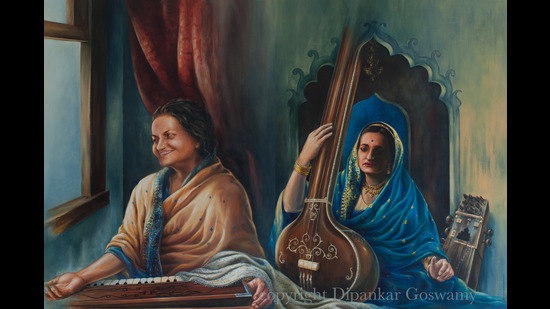
The sitar-surbahar duet of Raag Chandani Kedar by Ustad Vilayat Khan and Ustad Imrat Khan brings in an imaginary story around the Taj Mahal, where emperor Shah Jahan and his beloved Mumtaz Mahal’s souls ascend for a night of romance under the full moon. Here, while the sitar evokes Mumtaz Mahal, the sombre bass strokes of the surbahar played by Ustad Imrat Khan evoke Shah Jahan’s longing. The notes of the raag rendered in Devanagari are stylized with the slant of the Persian script to evoke the meherabs or architectural curves of the Taj Mahal.
The monumental Darbari Kanada by Ustad Moinuddin and Ustad Aminuddin Dagar has the royal grandeur of the Diwan-e-Khas, where they are depicted performing. The swaras faithfully support the weight of the majestic, melodic structure of the Raag Darbari in the same manner that its pillars supported the historic structure in Fatehpur Sikri, popularly believed to be the site of some of history’s most sublime renditions of the dhrupad form by the great Miyan Tansen. In Dipankar’s artistic vision, the holy fire in the havan-kund at the centre depicts the yajna of true notes or saccha sur of the musicians’ performance. The Mughal darbar is transformed into a devotional prayer hall with six bells representing the six notes culminating in the shadja.
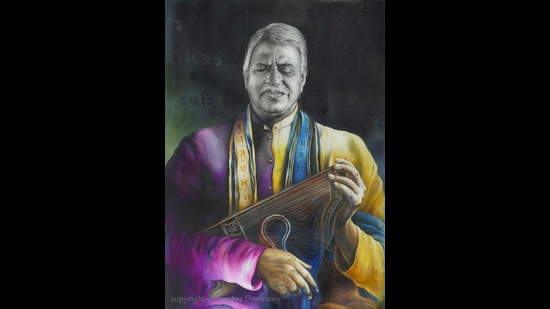
The dual images of the Mishra-Bandhu, Pandits Rajan and Sajan Mishra, merge into one, just like their music. The amalgamated person portrays that the duo are indeed “two hearts with one soul” as they like to define themselves.
Several other remarkable works are also part of RaagRang. Raags like Shri performed on the sitar by Pandit Nikhil Banerjee, Marwa on rudra veena by Ziya Mohiuddin Dagar, Raag Chandra-Nandan by Ustad Ali Akbar Khan on sarod, Bhairavi on the shehnai by Bismillah Khan, the famous Nat-Bihag bandish (composition) Jhan jhan jhan jhan paayal baaje by Pandit Mallikarjun Mansoor, Raag Desh by Pandit Hari Prasad Chaurasia, Nayaki Kanhada by Pandit Jasraj, Raag Miyan-Malhar on the sitar by Pandit Ravi Shankar and in a vocal rendition by Pandit Bhimsen Joshi also feature.
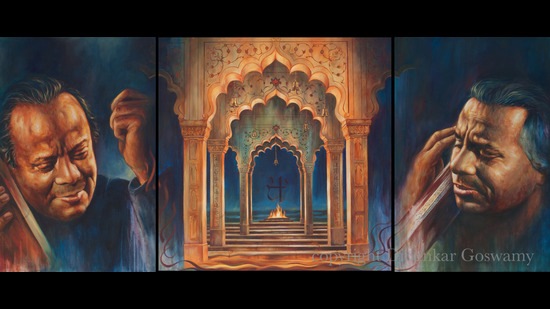
The sensitive perception of the Raag and the nuanced depiction of its melody made me curious about Goswamy’s upbringing and training in classical music and visual arts. Surprisingly, he spent his childhood and early youth in Munger, a small town in Bihar where classical music concerts were few and far between. He has never learnt classical music or joined any institution of art. After high school, he studied engineering at BITS, Pilani. However, his father, who was a professor of Physics, insisted that his children listen to classical music programmes on the radio. Goswamy remembers that he introduced them to Raag Malkauns by first playing Mann tadpat hari darshan ko aaj from the film Baiju-Bawra. Next, he put on a vinyl record of the same raga played on the sitar by Pandit Nikhil Banerjee, and finally, he made them listen to Pandit Omkar Nath Thakur’s famous bandish in Raag Malkauns, Peer na jane…. “We first listened to all these and were also inducted into listening to the All India Radio 9 pm classical National Programme of Music broadcasts. My sister and I were reluctant at first but gradually acquired a real taste for classical music without even being aware of it,” he says.
He has this interesting story to tell about his art training. In his last year at BITS, Pilani, he decided to leave engineering and pursue his passion by joining the JJ School of Arts in Bombay. He hopped onto a train to the city with all his paintings. Once there, he met the Dean, who patted his back, and said, “I would have taken you if you had come four years earlier but now you are at the threshold of getting a good job. Art is not a paying discipline. Earn money so that you can pursue your passion for art”.
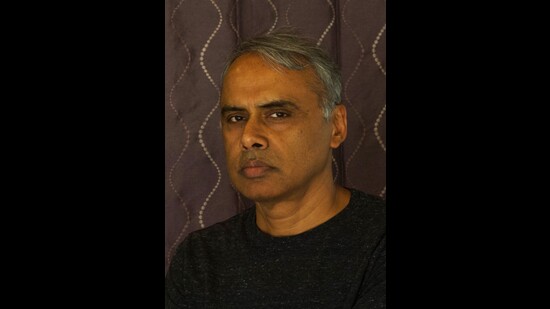
“I came back disappointed but during my internship period, I went to Calcutta and learned art under Shri Manas Chowdhury, younger brother of Pandit Deepak Chowdhury, the famous disciple of Pandit Ravi Shankar. He taught me the basics of drawing and the fundamentals of art from scratch. I continued practising on my own while I was at IIT Mumbai doing my Master’s in Visual Communication,” he says.
How does he carve out time for his art from his busy schedule at Imageworks? “I started working on RaagRang in 2009. I work after 9 or 10 pm at night for about 200 days a year. The project has been fuelled by my dogged passion for it over the last 13 years,” he says.
While Dipankar Goswamy has presented RaagRang at select gatherings in Mumbai, Kolkata, and Delhi in 2019, he hopes to exhibit it as a multimedia spectacle at galleries open to the general public as well.
Manjiri Sinha is a senior music critic.
Enjoy unlimited digital access with HT Premium
Subscribe Now to continue reading

Dipankar Goswamy, visual effects lead on Spiderman – Into the Spider-Verse that won the Academy Award for best animated feature film in 2019, has been associated with a number of projects including The Sea Beast, Vivo, Kingsman – The Golden Circle, Smurfs: The Lost Village, The Amazing Spiderman 2, and Oz the Great and Powerful. An alumnus of IDC, IIT, Mumbai, Goswamy, who has won numerous industry accolades, now creates photorealistic as well as painterly imagery for feature films with Sony Pictures Imageworks. Few, however, knew about his passion for providing a visual component to Indian classical music until the Bangalore International Centre (BIC) and the Museum of Art and Photography (MAP) live streamed his RaagRang: A Visual Exploration of North Indian Classical Music on 29 July 2022.
A powerful audio-visual experience, the stream presented paintings interwoven with the ragas they depicted. The voice-over included descriptions of the concept and logic behind each work. Goswamy has been working on the “portrayal” of raag-sangeet for over a decade and the project explores the intangible, abstract quality of Hindustani classical music through the tangible arts of painting, calligraphy, and through architectural three-dimensional effects and colour. “In a great concert, as the raga unfolds, the binaries disappear – the musician becomes the raga and the raga, the artiste. Ultimately, only the music remains,” says Goswamy, who attempts to express this process through the depiction of ragas rendered by those artists whose music has deeply moved him.
“For the last 13 years, I have been working on this personal project, a labour of love. It is an attempt to find an answer to the simple but inherently complex question ‘What does music look like?’ in the context of Indian classical music. This exploration has led me to create around 20 traditional paintings based on 14 themes of North Indian classical music. It is an ongoing project since the subject is so vast,” he says revealing that the aim is to present the often-intangible musical process by highlighting its multiple facets through traditional art and through innovations in computer graphics.
Planned in progressive stages, the RaagRang project begins with a series of paintings of famous musicians. Subsequent stages employ a more abstract visual language, creating an impressionistic colour imagery of these musical renditions, followed by a possible depiction of music as sculpture or three-dimensional paintings.
Loaded with visual metaphors, the paintings dig deep into the raag as well as the individuality of each musician. Dipankar liberally uses calligraphy in Devanagari and Nastaliq scripts to accentuate the swaras (notes) of the raag being rendered. Sometimes the Devanagiri is rendered like the Thuluth or the Siddham scripts to further enhance the message.
Each painting has something specific to say about the raag and the musician associated with it.
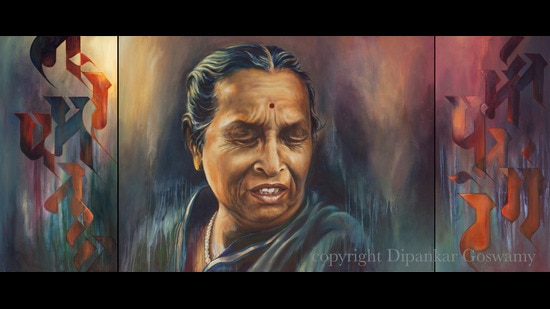
Raag Asawari sung by Gangu Bai Hangal, for instance, has the colours of the morning raag illuminating her face as calligraphy cascades down the sides of the image of the singer immersed in the dhyaan of the raag.
The ghazal Mere humnafas, mere humnawaan, mujhe dost ban ke dagha na de…. immortalized by Begum Akhtar is another subject. Goswamy turns the ghazal on its head by making it a dialogue between Begum Akhtar and her earlier incarnation, Akhtari Bai Faizabadi. Akhtari Bai accompanies the Begum in her rendition by providing the tanpura drone and sitting in Wajid Ali Shah’s glorious Kaiserbagh palace surrounded by the metaphors of the tawaif’s art. Urdu couplets of the ghazal appear as the embroidered border of a shawl that connects the two personas.

The sitar-surbahar duet of Raag Chandani Kedar by Ustad Vilayat Khan and Ustad Imrat Khan brings in an imaginary story around the Taj Mahal, where emperor Shah Jahan and his beloved Mumtaz Mahal’s souls ascend for a night of romance under the full moon. Here, while the sitar evokes Mumtaz Mahal, the sombre bass strokes of the surbahar played by Ustad Imrat Khan evoke Shah Jahan’s longing. The notes of the raag rendered in Devanagari are stylized with the slant of the Persian script to evoke the meherabs or architectural curves of the Taj Mahal.
The monumental Darbari Kanada by Ustad Moinuddin and Ustad Aminuddin Dagar has the royal grandeur of the Diwan-e-Khas, where they are depicted performing. The swaras faithfully support the weight of the majestic, melodic structure of the Raag Darbari in the same manner that its pillars supported the historic structure in Fatehpur Sikri, popularly believed to be the site of some of history’s most sublime renditions of the dhrupad form by the great Miyan Tansen. In Dipankar’s artistic vision, the holy fire in the havan-kund at the centre depicts the yajna of true notes or saccha sur of the musicians’ performance. The Mughal darbar is transformed into a devotional prayer hall with six bells representing the six notes culminating in the shadja.

The dual images of the Mishra-Bandhu, Pandits Rajan and Sajan Mishra, merge into one, just like their music. The amalgamated person portrays that the duo are indeed “two hearts with one soul” as they like to define themselves.
Several other remarkable works are also part of RaagRang. Raags like Shri performed on the sitar by Pandit Nikhil Banerjee, Marwa on rudra veena by Ziya Mohiuddin Dagar, Raag Chandra-Nandan by Ustad Ali Akbar Khan on sarod, Bhairavi on the shehnai by Bismillah Khan, the famous Nat-Bihag bandish (composition) Jhan jhan jhan jhan paayal baaje by Pandit Mallikarjun Mansoor, Raag Desh by Pandit Hari Prasad Chaurasia, Nayaki Kanhada by Pandit Jasraj, Raag Miyan-Malhar on the sitar by Pandit Ravi Shankar and in a vocal rendition by Pandit Bhimsen Joshi also feature.

The sensitive perception of the Raag and the nuanced depiction of its melody made me curious about Goswamy’s upbringing and training in classical music and visual arts. Surprisingly, he spent his childhood and early youth in Munger, a small town in Bihar where classical music concerts were few and far between. He has never learnt classical music or joined any institution of art. After high school, he studied engineering at BITS, Pilani. However, his father, who was a professor of Physics, insisted that his children listen to classical music programmes on the radio. Goswamy remembers that he introduced them to Raag Malkauns by first playing Mann tadpat hari darshan ko aaj from the film Baiju-Bawra. Next, he put on a vinyl record of the same raga played on the sitar by Pandit Nikhil Banerjee, and finally, he made them listen to Pandit Omkar Nath Thakur’s famous bandish in Raag Malkauns, Peer na jane…. “We first listened to all these and were also inducted into listening to the All India Radio 9 pm classical National Programme of Music broadcasts. My sister and I were reluctant at first but gradually acquired a real taste for classical music without even being aware of it,” he says.
He has this interesting story to tell about his art training. In his last year at BITS, Pilani, he decided to leave engineering and pursue his passion by joining the JJ School of Arts in Bombay. He hopped onto a train to the city with all his paintings. Once there, he met the Dean, who patted his back, and said, “I would have taken you if you had come four years earlier but now you are at the threshold of getting a good job. Art is not a paying discipline. Earn money so that you can pursue your passion for art”.

“I came back disappointed but during my internship period, I went to Calcutta and learned art under Shri Manas Chowdhury, younger brother of Pandit Deepak Chowdhury, the famous disciple of Pandit Ravi Shankar. He taught me the basics of drawing and the fundamentals of art from scratch. I continued practising on my own while I was at IIT Mumbai doing my Master’s in Visual Communication,” he says.
How does he carve out time for his art from his busy schedule at Imageworks? “I started working on RaagRang in 2009. I work after 9 or 10 pm at night for about 200 days a year. The project has been fuelled by my dogged passion for it over the last 13 years,” he says.
While Dipankar Goswamy has presented RaagRang at select gatherings in Mumbai, Kolkata, and Delhi in 2019, he hopes to exhibit it as a multimedia spectacle at galleries open to the general public as well.
Manjiri Sinha is a senior music critic.
Enjoy unlimited digital access with HT Premium
Subscribe Now to continue reading

